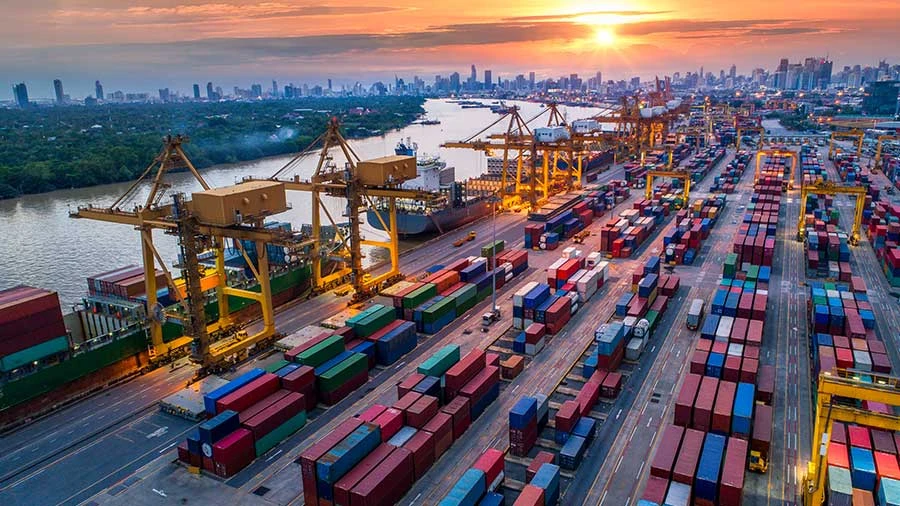
After enduring the most protracted decline in exports in over a decade, Vietnam faced a drop in domestic manufacturing activities during the initial seven months of the year. Despite these challenges, promising indicators suggest a turnaround is in progress. Vietnam's exports, which experienced a 10% year-on-year reduction in 2022, are poised for recovery in the fourth quarter, largely attributed to a stabilization of the inventory cycle in the United States.
Transforming Decline into Advantage
The United States stands as a pivotal market for Vietnam's exports, constituting approximately a quarter of the total export value. American retailers and consumer goods giants like Nike and Lululemon significantly ramped up orders for products bearing the "Made in Vietnam" label over the last year, banking on an economic resurgence following the aftermath of the Covid-19 pandemic.
However, these expectations took an unexpected turn. Rather than bolstering consumer goods consumption, the US witnessed a shift towards expenditures on travel and dining experiences. Consequently, by the close of 2022, corporations such as Walmart, Target, and Nike found themselves grappling with an inventory surge of over 20% compared to the previous year.
In response to excessive inventory levels, multinational enterprises curtailed their orders at Vietnamese factories. This led to a significant contraction of over 20% in Vietnam's exports to the US during the initial seven months of 2023, in contrast to the same period in the previous year. However, efforts by US companies to trim their inventories have been palpable throughout this year. Notably, recent announcements from retail giants Walmart and Target highlighted substantial reductions in their inventories compared to the same period last year.
Remarkable strides to reduce inventory levels by American corporations, exemplified by Walmart, played a pivotal role in driving a notable surge in Vietnam's exports to the US. July witnessed a nearly 7% spike in exports compared to June. In effect, Vietnam's exports to the US showcased significant progress, with the decline narrowing from 26% in June, as compared to the previous year, to a more manageable 14% in July. This resurgence significantly contributed to the recovery of Vietnam's overall export value, transitioning from a 12% year-on-year decline in the first half of 2023 to a modest 2% dip in July.
Beyond the revival of exports to the US, Vietnam's benefit also stems from the relocation of production operations from China. This strategic shift, prompted by the trough of the inventory cycle, has positioned Vietnam to absorb production from China. Consequently, Vietnam's export contraction in July was limited to a mere 2%, outperforming the substantial declines of 15% in China, 16% in South Korea, and 10% in Taiwan.
Sustainability of the Recovery
Vietnam's improved export order conditions, coupled with a noteworthy 4% month-on-month boost in industrial output in July, led to an upward trajectory for the country's PMI index—from 46.2 in June to 48.7 in July. Presently, enterprises are embracing a strategy of increased import and procurement of input materials. This strategic move is geared towards gradually scaling up production activities, underpinned by the anticipation of export order recovery by year-end.
At present, over half of Vietnam's export value to the US comprises high-tech offerings such as consumer electronics and smartphones, along with garments and footwear. The remainder encompasses products like furniture and agricultural goods. Despite witnessing a substantial 30% year-over-year decline in global sales of personal computers earlier in the year, the slump in personal computer and consumer electronics sales has come to a halt.
The outcome of this reversal is evident in Vietnam's electronic products exports, which experienced a noteworthy turnaround—from a 3% year-on-year contraction in June to a remarkable 28% growth in July. This resurgence played a pivotal role in driving Vietnam's export recovery, resulting in an unprecedented export turnover of over $30 billion, marking a significant milestone for the current year.
Capitalizing on its position as the world's second-largest exporter of smartphones, Vietnam is poised to be significantly impacted by the launch of new-generation smartphone models. A prime example is Samsung, which single-handedly contributes a quarter of the nation's total export value. Despite a 12% year-on-year decline in smartphone sales during the second quarter, aligning with a global trend, Samsung anticipates a resurgence in the latter half of the year. This optimistic outlook is driven by the introduction of new phone models, particularly foldable ones.
Parallel to Samsung's efforts, major players like Apple and Google are also gearing up for impactful product launches. Although these new phone models will not be physically manufactured in Vietnam, the country will play a pivotal role in their production. Key components for these devices are slated to be manufactured in Vietnam by suppliers including Foxconn, Luxshare, and Goertek.
Conversely, the rebound for apparel and footwear exports, representing nearly 20% of Vietnam's total exports, is projected to extend into the following year. This projection is substantiated by the gradual pace of inventory reduction among US retailers for these products. Nonetheless, July saw a surge of approximately 30% in month-on-month apparel exports to South Korea and Japan. This upward trajectory can be attributed to resurging demand for fashion products in these markets, as revealed by a survey of domestic consumer sentiment.
The anticipated recovery holds the potential to catapult Vietnam's GDP growth from its current level of less than 5% in 2023 to an impressive 6.5% in 2024. This projected growth trajectory is poised to accelerate profit expansion for listed businesses, projecting an increase from 6% in 2023 to an impressive 20% or more in 2024. These developments are set to lend support to the VN Index in the months ahead, affirming Vietnam's resolute commitment to economic revival in a dynamic global landscape.




















